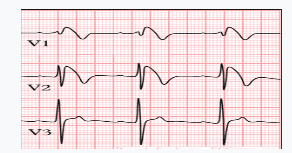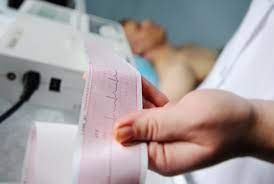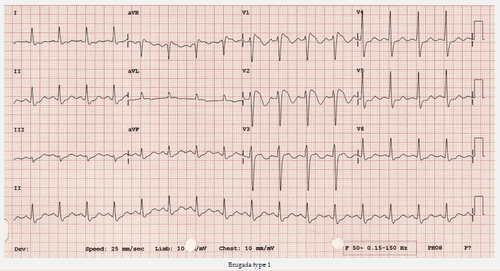This is an automatically translated article.
Article written by Master, Doctor Vu Thi Tuyet Mai - Cardiologist - Cardiovascular Center - Vinmec Central Park International General Hospital.
Brugada syndrome is a primary electrical and ion channel disease of the heart that causes an abnormal heart rhythm coming from the ventricles (lower chambers of the heart), without structural cardiac abnormalities. Patients often have episodes of syncope or sudden death due to ventricular tachycardia or ventricular fibrillation. Brugada syndrome is a rare disease that is inherited from one parent. It was first discovered in 1992. Since then, a lot has been learned about the disease, but many questions remain unanswered. Researchers are continuing to study Brugada syndrome and test new treatments.
1. Features of Brugada's syndrome
High risk of sudden death. Manifestations are usually in adults, the age of sudden death is about 40 years old. accounted for 4-12% of sudden death. 20% of sudden deaths have structurally normal hearts. Frequency 5/10 000 population. ECG changes: ST-segment elevation in the right thoracic leads.

2. What are the symptoms of Brugada syndrome?
Symptoms of Brugada syndrome may include:
Ventricular tachycardia (rapid, irregular heartbeat that begins in the ventricles). Faint. Fast heartbeat (may feel like fluttering or heaving in your chest). Atrial fibrillation (rapid, irregular heartbeat that begins in the atria). Cardiac arrest, usually at night due to ventricular arrhythmias (this may be the first symptom). Symptoms of Brugada Syndrome are similar to many other conditions. It is important to see a doctor to find out what is causing the symptoms.
Asymptomatic form: The electrocardiogram has a characteristic picture of Brugada syndrome but the patient has no clinical manifestations.
Hidden form: The patient carries a gene mutation but has no clinical and electrocardiographic symptoms even when tested with antiarrhythmic drugs.
3. What causes Brugada syndrome?
Brugada syndrome is usually caused by a genetic mutation. The defect changes the way the heart's ion channels work.
4. Is it necessary to be screened for Brugada syndrome?
Brugada syndrome is a medical condition that can be passed down from generation to generation. If we have first-degree relatives, parents, siblings and children with Brugada disease, we must be screened for the disease.
5. How is Brugada syndrome diagnosed?
Diagnostic tests for Brugada Syndrome include:
Improved lead electrocardiogram (ECG) with V1 - V3 set higher. Holter ECG 24 hours. Stress electrocardiogram. Antiarrhythmic drug stimulation test. The ECG abnormalities characteristic of brugada can be revealed by sodium channel blockers, such as administration of flecainide, ajmaline, or procainamide. Based on ECG results, and symptoms may require further testing:
Electrophysiological (EP) exploration : To stratify the risk of patients who are asymptomatic despite ECG imaging. Brugada photo. Genetic testing to confirm specific gene mutations that indicate Brugada Syndrome.

6. What are the treatments for patients with Brugada syndrome?
Patients with a diagnosis of Brugada Syndrome and a history of ventricular arrhythmias or sudden life-saving sudden death who are considered to be at high risk, are assigned an implantable defibrillator (ICD) for the prevention of sudden death. There is no drug for the prevention of sudden death in patients diagnosed with Brugada, although studies suggest a benefit of quinidine. Antiarrhythmic drugs may have a role in patients who have had an ICD implanted and who require frequent defibrillation.
7. Who is at risk for Brugada syndrome?
Brugada syndrome is more common in men than in women. In fact, men are 8 to 10 times more likely to develop this condition than women. All patients with a family history of sudden death syndrome or Brugada should be screened.
8. What is the prognosis of patients with Brugada syndrome?
People with Brugada Syndrome have symptoms but if left untreated are at high risk of sudden death. Patients who are asymptomatic and have a normal ECG at baseline have a much lower risk of sudden death. Patients with suspected Brugada Syndrome should be examined and consulted with a cardiologist to prevent sudden death.
Vinmec International General Hospital is a reliable address for treatment and prevention of diseases. In particular, at Vinmec Da Nang Hospital, there is a team ready for cardiovascular intervention to place an ICD defibrillator in the treatment of Brugada Syndrome. When performing the examination process at Vinmec, customers will be welcomed and used modern facilities and machinery along with perfect medical services under the guidance and advice of doctors. Good doctors, well-trained both at home and abroad.
Please dial HOTLINE for more information or register for an appointment HERE. Download MyVinmec app to make appointments faster and to manage your bookings easily.














